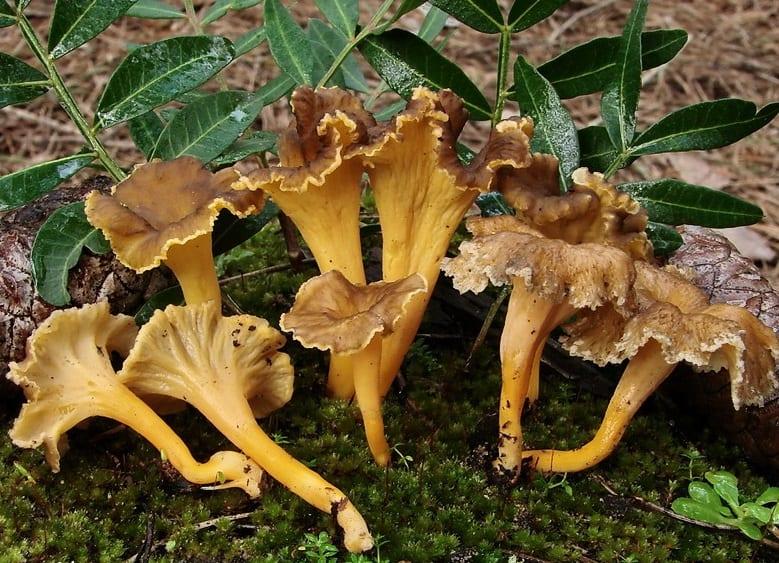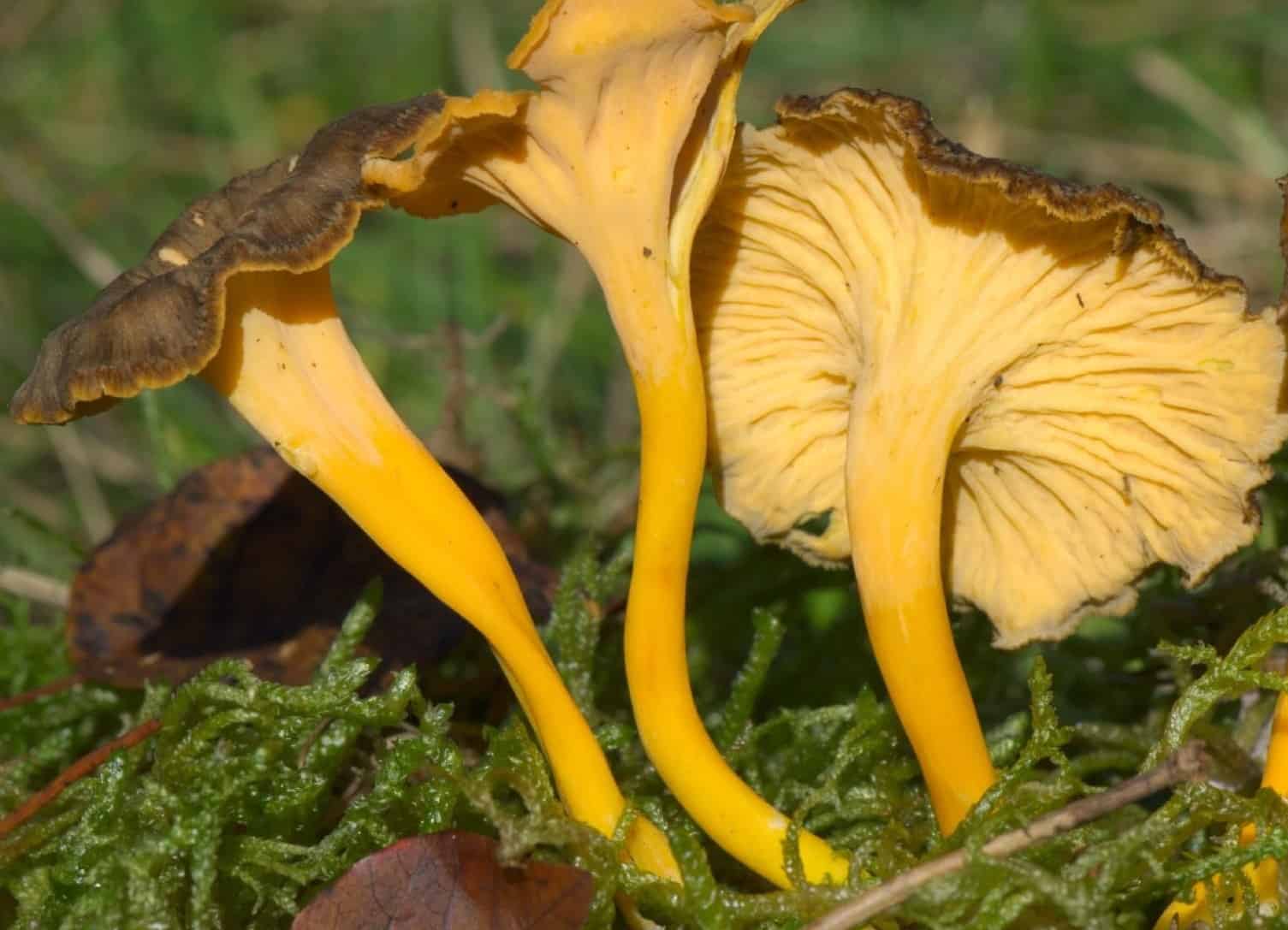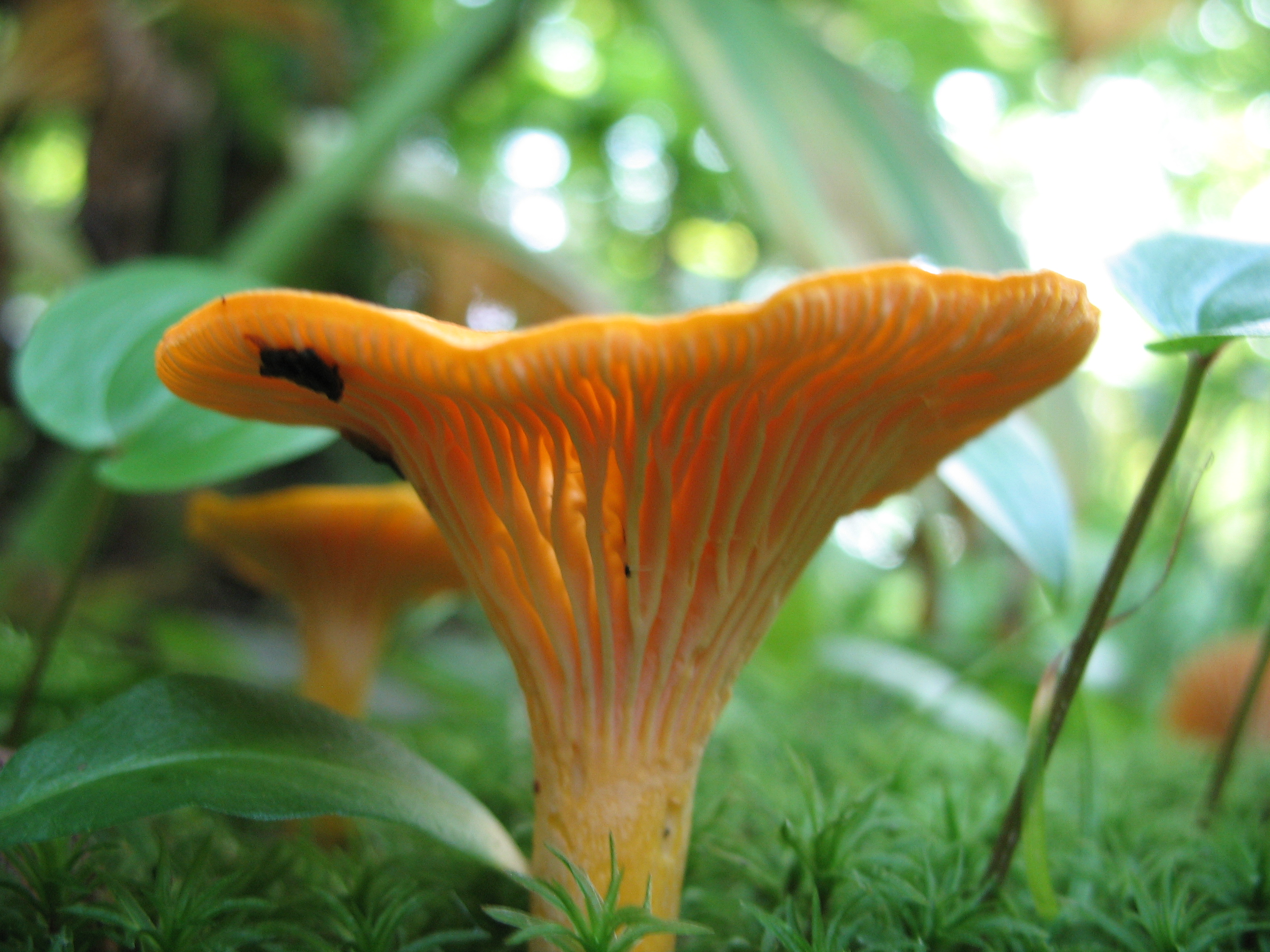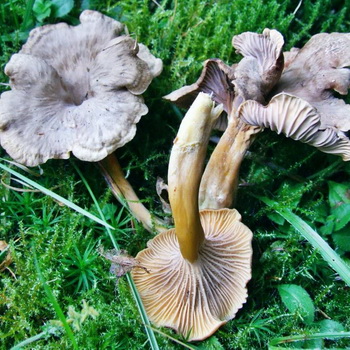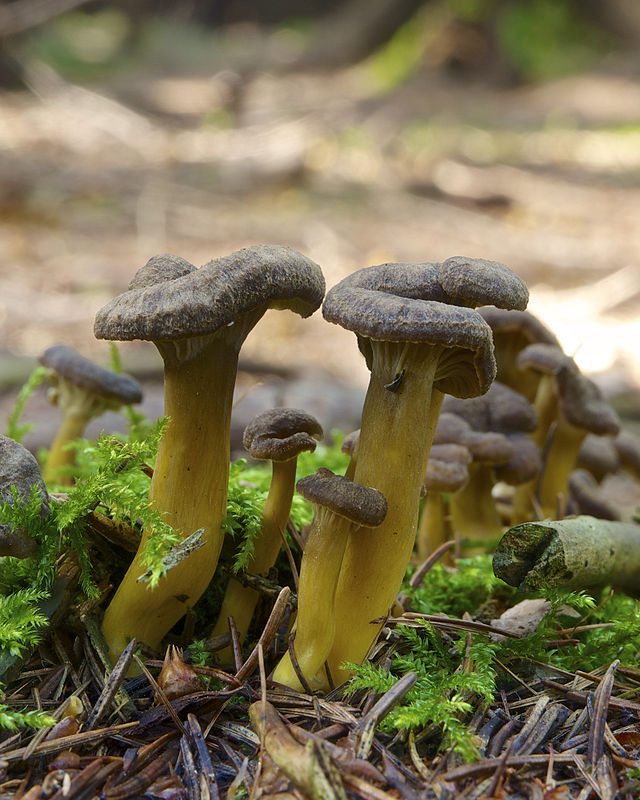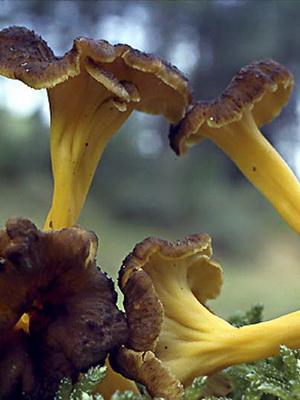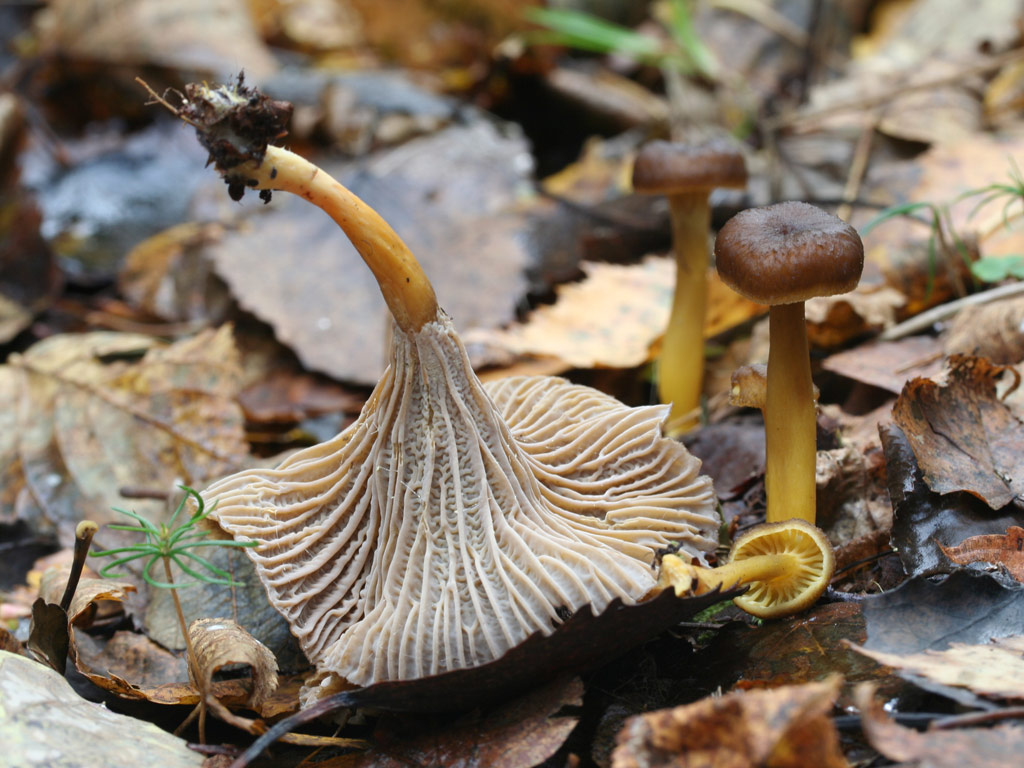Chanterelle species, appearance
The chanterelle tubular, or funnel-shaped (Cantharellus tubaeformis) belongs to the Chanterelle family, popularly called the chanterelle, cantarella.

The genus of chanterelles is very large, varieties and types of mushrooms (tubular and lamellar) from the Chanterelle family:
- The tubular chanterelle has very small cap sizes, they rarely exceed 5-6 cm in diameter, the cap forms a narrow funnel, its color can be yellow, reddish, brownish. The leg is hollow, very long (up to 10 cm), sometimes slightly compressed from the sides. The white pulp has a slightly bitter, pleasant taste, it smells slightly of plums (Mirabelle variety). Funnel-chanterelle mushrooms (photos, pictures, see the section of 50 pictures) usually grow in very dense clusters, one next to the other.
- The chanterelle (real) is a mushroom with a cap reaching 12 cm in diameter, the edges are wavy, in the center of the cap there is a funnel-like depression. The color of the cap and the leg is the same - yellow in different shades. The flesh of the cockerels is dense, fleshy, the smell is slightly sour, reminiscent of the smell of dried fruits. The pressed places turn a little red. The plates are wide, rather thick, have the same color as the whole mushroom. Mushrooms are rarely wormy, the substance quinomannose in the pulp inhibits the vital activity of pests. The real chanterelle grows in groups on all continents in a temperate climate, in coniferous forests, in mixed massifs.
- Chanterelle pallor (white) is very similar to the real one, differs from it in a more faded color (sometimes even white) of the fruit body. It grows at the same time in similar areas, although it prefers deciduous forests over spruce forests.
- The chanterelle is gray in the shape of the fruiting body, similar to a real chanterelle, it differs in the color of the cap, it is gray, brown, ashy, the bottom of the cap is usually slightly lighter. The cap is wrinkled, the edges are twisted.
- The amethyst chanterelle grows to a large size (up to 10 cm in diameter), the yellow color of the cap is diluted with spots of purple scales, which are denser at the center of the depression. It acquires the shape of a funnel after it has passed the young stage of growth. The leg is dense, with a diameter that decreases towards the ground. Quite a rare species that prefers mixed forests, massifs of broad-leaved trees. Often adjacent to beech, found in southern Russia from mid-summer to late autumn. It grows in circles, in large families.
- The type of chanterelle is velvety, Frieza (orange funnel), this species pleases the eye with a bright orange (sometimes with a reddish tint) color of the cap. The species is rare. The pulp is slightly bitter, with a pleasant aroma. Grows on acidic soils of southeastern Europe, in July-October.
- The species horn-shaped funnel, or black chanterelle, a mushroom (photos and descriptions of this genus are given below), belonging to the genus Funnels, the Chanterelle family, look like narrow black funnels with wavy edges. The stem of the mushroom is very short, it is almost invisible, the height of the cap reaches 12 cm, diameter is up to 8 cm. It grows in the mountainous regions of Europe. Edible.
Also in the family there is a clavate chanterelle species.
Beneficial features
Chanterelles contain many useful substances and trace elements, and are used to treat and prevent a whole range of various ailments - from fighting infections, and lowering cholesterol, to fighting cancer.
Chanterelle mushrooms always delight gatherers with their tendency to grow in large friendly families, and connoisseurs of mushroom cuisine with their famous luxurious taste. A huge number of their varieties allows you to find, if not some, then other species of chanterelles, during a quiet hunt, and in summer and autumn forests.There are as many recipes for cooking gorgeous chanterelle dishes as there are housewives in the world, and these mushrooms continue to delight us with different facets of their wonderful taste.
Do you collect chanterelles?
Yes
100%
No
0%
I plan to start
0%
Voted: 1
L-L-L-L-L:
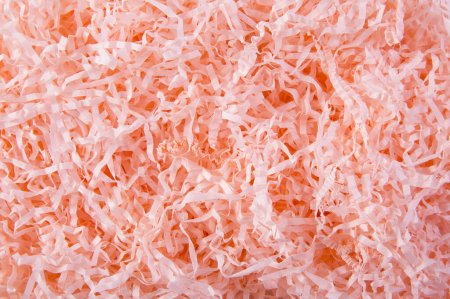 Burgundy - burgundy
Burgundy - burgundy
.
 In the morning
In the morning
.
 In the morning
In the morning
.
 Barton, barton, barton Bumpy flare. Rosewood and Rosewood
Barton, barton, barton Bumpy flare. Rosewood and Rosewood
.
 ÐÑк ursinum Ð »Ð¸ÑÑÑÑ, иР· вÐμÑÑнÑÐμ кР° к Ð'икий ÑÐμÑнок, ÑÐ ° мÑонÑ, пÑÑжки, ÑиÑокол иÑÑвÐμннÑÐμ ÑÐμÑнок, Ð'ÑÐμвÐμÑнÑй ÑÐμÑнок, Sauerkraut
ÐÑк ursinum Ð »Ð¸ÑÑÑÑ, иР· вÐμÑÑнÑÐμ кР° к Ð'икий ÑÐμÑнок, ÑÐ ° мÑонÑ, пÑÑжки, ÑиÑокол иÑÑвÐμннÑÐμ ÑÐμÑнок, Ð'ÑÐμвÐμÑнÑй ÑÐμÑнок, Sauerkraut
.
 Rosewood Inonotus obliquus Rosewood Inonotus obliquus Rosewood Inonotus obliquus Rosewood Good luck. Rosewood and Rosewood
Rosewood Inonotus obliquus Rosewood Inonotus obliquus Rosewood Inonotus obliquus Rosewood Good luck. Rosewood and Rosewood
.
 Rosewood Inonotus obliquus Rosewood Inonotus obliquus Rosewood Good luck. Rosewood and Rosewood
Rosewood Inonotus obliquus Rosewood Inonotus obliquus Rosewood Good luck. Rosewood and Rosewood
.
 Approx. Donut Quick and easy. Burgundy
Approx. Donut Quick and easy. Burgundy
.
Chanterelles - the most effective natural remedy for parasites: how to cook and take - Vasily Lychkovsky - KONT
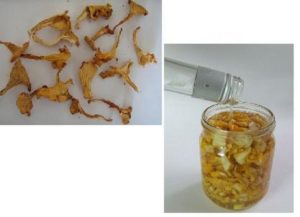
If you think that the topic of parasites does not concern you - get acquainted with the statistics data: according to data WHO, parasitic diseases are infected with almost 75% population of the Earth, regardless of the standard of living! Such statistics are the same for both developing and quite prosperous developed countries.
According to the same source, practically 80% of all existing diseases are either directly caused by parasites, or are a consequence of the vital activity of parasites in our body!
And here is the unofficial data collected by the method biofrequency resonance diagnostics - helminthic invasions almost 100% of the population of Russia is infected (!),parasitic diseases infected almost 80% of the world's population.
(there will be a separate article on the method of biofrequency resonance diagnostics - V.L.)
Of 10 people randomly selected "from the street" and examined using this method, only half of them had less than 8 types of parasites in their bodies, the rest, on average, from 8 to 15 species! I emphasize again -SPECIES, not individuals!
It's no secret that:
1. asthma associated in 100% of cases with ascaris larvae2. a consequence of damage to the pancreas by a trematode diabetes mellitus in some cases - a consequence of damage to the pancreas by a trematode 3. roundworm larvae eczema and psoriasis Is a disease caused by roundworms4. Iron-deficiency anemia - associated with infection with hookworm and roundworm5. Chlamydia, Trichomonas, Staphylococcus Protozoa unicellular organisms (Chlamydia, Trichomonas, Staphylococcus) affect children already in the womb
6. Parasitic diseases are the cause of mental and physical retardation of children and decrease in the working capacity of adults.
Parasite NO
————————————–
Raising the topic yesterday "Ivanchenko's Russian troichetka from parasites - how to do it yourself and how to take it .." I didn't expect such a continuation. What is good about the information collective intelligence - the Internet - is its efficiency.
One of the readers drew my attention to another natural remedy for parasites - chanterelles. I am very interested in methods, techniques, techniques, techniques, etc. for health improvement, which do not require large financial costs and have a real effect from the application
Collect chanterelles, dry them or prepare an infusion with vodka, take them raw, well, what could be even easier ...
I am very interested in methods, techniques, techniques, techniques, etc. for health improvement, which do not require large financial costs and have a real effect from the application. Collect chanterelles, dry them or prepare an infusion with vodka, take them raw, well, what could be even easier ...
I also suggest that you familiarize yourself with the selection of materials. - V. Lychkovsky.
————————————
Chanterelles – the most effective natural remedy for parasites: how to prepare and take
Chanterelle, "cockerel" - bright yellow elegant mushroom, widespread in Russian forests everywhere. It grows in large families and you can often find whole meadows covered with large and very small fungi.
It is widely used in cooking and in its taste is not inferior to "noble" mushrooms. But the main wealth of chanterelles is not their excellent taste, but useful substances.
Mushrooms contain:
chitinmannose; organic acids; amino acids; organic acids; vitamins; carotene;
polysaccharides.
The healing properties of bright yellow mushrooms have been studied for a long time.
The value of chanterelles is in their "ability" to fight parasites of the human body.
Chanterelle treatment for parasites has been known since time immemorial. Even village sorcerers successfully drove the "hearty worms" with tinctures of chanterelles. In addition, the red fungus saved themselves from liver inflammation, childhood rickets, and oncological diseases.
Comparison of real and false chanterelles
Every lover of collecting forest gifts should know what a false chanterelle looks like. To determine the differences, it is necessary to familiarize yourself in detail with each of the types. Such varieties of chanterelles as tubular, gray, white and others do not have twins, but an ordinary cockerel can be confused with an orange talker.
The chanterelle is real
False chanterelle
Despite the fact that edible and false specimens are very similar, an experienced mushroom picker can easily tell them apart. This is where a simple tip from a seasoned forest lover comes in handy. Despite the fact that these are delicious mushrooms, it should be remembered that they have counterparts. I'll tell you how I define chanterelles: you can focus on the color of their hats and the shape of their legs. So, everyone's favorite bettas are distinguished by a muted reddish color.
The surface of their cap is matte, always smooth, the skin almost does not separate from the pulp - thick, juicy, corresponding to the shade of the leg. Sometimes the flesh of the mushroom can be very light, almost white. When broken and pressed, it turns slightly red.
The edges of the cap at a young age are smooth, neatly rounded. As they grow, they bend beautifully, become wavy at the edges, and the fruit body acquires a slightly funnel-shaped shape with a deepened center.
A real chanterelle is capable of growing to a large size. Often there are specimens with a cap diameter of about 10-12 cm.
Chanterelle mushrooms have a thick and strong stem. It expands at the top and merges smoothly into the cap. The color of the fruiting body does not change throughout, it has uniformity. The leg thickness is from 10 to 30 mm, the length is up to 7 cm. It is slightly lighter than the cap.
Males do not have plates, the hymenophore consists of frequent, highly branched folds that descend to the pedicle, making up one whole with it.
The color of the caps of the false chanterelle is brighter than that of the real ones. So, when collecting gifts from the forest, the mushroom picker should be alerted by the yellow or orange, slightly velvety surface of the specimen encountered.The diameter of the cap of the kokoshka does not exceed 6 cm, the plates descend to the stem. They are frequent, thin, bright. The pulp is white or yellow, with a sharp mushroom odor (if the aroma is sweetish, then this also indicates that the specimen belongs to the genus Gigroforopsis).
A pronounced difference between these mushrooms is that they have a rather thin (up to 10 mm) and long (up to 5 cm) stem. It is flat, but rarely curved. Inside - fibrous, with pulp resembling cotton wool. The color of the flesh of the leg does not match the shade of the cap; at the base it is darker (almost black).
Key differences
So, you need to remember the difference between representatives of two types of eukaryotes. They are as follows:
- False chanterelles have a brighter color. Cockerels have a calm reddish tone.
- If the mushroom has a sour taste, and its leg is thick and smoothly turning into a cap, then this is an ordinary chanterelle. Such a mushroom has a slightly curved leg shape. Kokoschki have a thin and hollow stem.
- The chanterelle mushroom grows in large colonies, the kokoschka - almost always single specimens. It can be found on fallen and rotting tree trunks.
- All kinds of worms and larvae are very fond of eating false chanterelles, while cockerels are extremely rarely spoiled by insects. The only worm that can be found when cutting the fruit body of a cockerel is the wireworm. This fact is explained by the presence of a large amount of chitinmannose in the fruiting bodies of common chanterelles.
- Another difference is that false eukaryotes have an easily peelable skin. When it is removed, the rough surface of the cap is exposed. It is almost impossible to peel off the skin of cockerels.
- In orange talkers, the color of the plates is brighter than the tone of the cap, while in roosters it is uniform and uniform over the entire surface.
These are the main characteristics that show how one species differs from another.
Description of the tubular chanterelle
The tubular chanterelle, or Cantharellus tubaeformis, belongs to the class of agaricomycetes and is an edible species. Because of the characteristic cap, elongated in the shape of a funnel, mushroom pickers nicknamed the mushroom "funnel chanterelle"
The appearance of the mushroom
Tubular chanterelle mushroom of medium size, yellow-brown color. At the beginning of growth, it has an even or slightly convex cap, which, as the fungus grows, becomes funnel-shaped and elongated. The diameter rarely even reaches 6 cm, the average size is considered to be 2-4 cm. The entire cap is covered with thin veins, which are darker in color than the chanterelle itself. The edges point down.
- The pulp is elastic, easy to chew, has a pronounced mushroom taste and a pleasant aroma.
- The spore-bearing layer has a gray color, is located on the back of the cap and looks like many veins that tend to the stem of the fungus.
- The leg is located in the center, has a cylindrical shape, its height is 4-7 cm, and its thickness is from 0.4 to 0.8 cm. The leg smoothly passes into the cap, the joint is dark.
Mushroom species
Mushrooms are called tubular or lamellar. The chanterelle belongs to the lamellar representatives and does not have dangerous poisonous counterparts, with which it would be easy to confuse it. The Chanterelle family itself is characterized by the presence of 5 genera, in which there are more than 90 species.
The tubular chanterelle is most similar to the following representatives:
- Amethyst chanterelle. It is also an edible mushroom. It is distinguished by a large head diameter (10 cm) and a stem that thickens up to 4 cm. The same funnel shape is preserved. This representative is found in all forests: deciduous, coniferous, mixed and herbaceous. Such mushrooms prefer to grow in colonies. Suitable for all types of workpieces.
- Common chanterelle. Its main difference is the absence of a dark color at the junction of the stem and cap. There are no plates. Their place is taken by wavy folds or veins, the color of which coincides with the main color of the mushroom - light yellow. This species has a light fruity aroma. It will not be difficult to collect a large harvest, because.mushrooms never grow alone.
- Black chanterelles, or horn-shaped funnel. The main feature of this edible mushroom is its black color. The height reaches 10 cm, the diameter of the cap is cm, its edges are strongly bent inward, the thickness of the leg is only 0.8-1 cm. The funnel belongs to the 4th taste category, it needs preliminary processing before eating.
Beneficial features
Chitinmannosis, ergosterol, trametonolinic acid and other polysaccharides contained in chanterelles are a good prevention of the appearance of worms. Ergosterol helps cleanse and restore liver function. This leads to the use of various extracts from this type of fungi in the treatment of hepatitis C and other liver diseases.
Contraindications
The use of this type of food is prohibited for pregnant or lactating women. Also, a contraindication is the individual intolerance of the components that make up the mushrooms. It is strictly forbidden to treat children with their use.
In cooking
Tubular chanterelle does not require pre-boiling. It is consumed fresh. So it retains all the beneficial properties and brings maximum benefit.
It is possible to use chanterelles for all types of workpieces and for cooking various dishes. They are pickled, fried and boiled, from this they do not become harder and do not lose their taste. Heat treatment destroys all useful elements.
In medicine
The tubular chanterelle has not found application in official medicine, but in some eastern countries it has established itself as an antihelminthic and hepatoprotective agent.
The effect is achieved due to the large amount of useful polysaccharides in the pulp. It is believed that regular consumption of chanterelles in food improves vision and prevents the appearance of inflammatory processes in the eyes, increases the resistance of immunity to infectious diseases.
Places of growth of yellowing chanterelles.
Fruiting in yellowing chanterelles is observed from August to September. They inhabit coniferous forests, most often found in spruce forests. They grow in groups. Mushroom pickers do not often come across this species.
Evaluation of the edibility of yellowing chanterelles.
In terms of taste, yellowing chanterelles belong to the 4th category. The culinary value of these mushrooms is that they do not break, do not crumble and are never wormy. They can be boiled, fried and dried.

The benefits of yellowing chanterelles.
Chanterelles benefit the body due to their multicomponent composition - they contain many minerals, vitamins and a special substance of quinomannose. It is a polysaccharide that is active against adult helminths, which is why forest insects do not touch their fruiting bodies. Due to this, chanterelles are an excellent anthelmintic. But for the fight against parasites, only dried fruit bodies are suitable, since quinomanosis is destroyed during heat treatment.

Yellowing chanterelles are rich in potassium, fluorine, manganese, zinc, calcium, magnesium, sulfur, copper, cobalt and other minerals. They also contain other beneficial substances, such as amino acids.
When using yellowing chanterelles, the immune properties of the body are enhanced. These mushrooms are used to make medicines used to treat eye diseases that help improve vision and get rid of dryness. They also help with skin conditions such as boils and abscesses. Chanterelles are useful for angina. They destroy the tuberculosis bacillus. They are recommended to be eaten for diseases of the pancreas, heart and blood vessels.

Although yellowing chanterelles are rich in composition and high in protein, they are low in calories, so they can be safely consumed by obese people. With their regular use, radionuclides are removed from the human body.The active substances that make up the yellowing chanterelles help with joint pain, insomnia, anemia, and liver diseases.
Chanterelles are also used in cosmetology. An extract is made from the fruit bodies of these mushrooms, which helps with bacterial and fungal skin diseases. The skin becomes more hydrated and softer.
Harm of yellowing chanterelles.
Like other mushrooms, yellowing chanterelles are not recommended for children under the age of 3 years. There may also be individual intolerance.
Contraindications to the use of chanterelles are diseases of the stomach, intestines and kidneys. Also, they should not be eaten during pregnancy.
Related species of yellowing chanterelle.
The tubular chanterelle is also an edible mushroom. His cap is funnel-shaped, the edges are bent down, uneven. Color from gray-yellow to brown, sometimes reddish. The pulp is dense, thin, bitter in taste with a pleasant earthy smell. The flesh is white in color. The leg is tubular, laterally compressed, cylindrical, dull yellow in color.

Tubular chanterelles grow on acidic soils. Most often they form mycorrhiza with conifers, and much less often with deciduous ones. You can find them on rotten wood or among the moss. They are common in the temperate zone. Fruiting in large rings and rows. Collect them from September to December.
The chanterelle is also edible. It differs in that in youth it has a purple tint, but when it matures, it becomes yellowish. The cap is wavy at the edges. The stem is smooth, very dense, light brown in color. The pulp is white.
Fruiting of clavate chanterelles occurs from summer to autumn. They grow mainly in deciduous forests. They hide in the grass and moss.
L-L-L-L-L:
 Craterellus lutescens Cantharellus lutescens Cantharellus xanthopus Cantharellus aurora, donut Yellow foot Yellow Ð ± ов. Burgundy, burgundy
Craterellus lutescens Cantharellus lutescens Cantharellus xanthopus Cantharellus aurora, donut Yellow foot Yellow Ð ± ов. Burgundy, burgundy
.
 Capillary Hazelnuts, Corylus avellana capillary, capillary, capillary Rose, Rose, Rose, Rose, Rose, Rose, Rose, Rose, Rose, Rose, Rose, Rose, Rose, Rose , Flat
Capillary Hazelnuts, Corylus avellana capillary, capillary, capillary Rose, Rose, Rose, Rose, Rose, Rose, Rose, Rose, Rose, Rose, Rose, Rose, Rose, Rose , Flat
.
 Craterellus lutescens, Cantharellus lutescens, Cantharellus xanthopus, Cantharellus aurora, Red, Yellow, Yellow It's good to go. Lightning
Craterellus lutescens, Cantharellus lutescens, Cantharellus xanthopus, Cantharellus aurora, Red, Yellow, Yellow It's good to go. Lightning
.
 Rosewood Inonotus obliquus Rosewood Inonotus obliquus Rosewood Good luck. Rosewood and Rosewood
Rosewood Inonotus obliquus Rosewood Inonotus obliquus Rosewood Good luck. Rosewood and Rosewood
.
 Lol lokl lokl lokl lokl lokl. Bark, bark, bark, bark, bump Good luck. Sprinkle
Lol lokl lokl lokl lokl lokl. Bark, bark, bark, bark, bump Good luck. Sprinkle
.
 Barton, barton, barton Bumpy flare. Rosewood and Rosewood
Barton, barton, barton Bumpy flare. Rosewood and Rosewood
.
 Bush, bush, bump. Burgundy, burgundy Contact us. Lightning
Bush, bush, bump. Burgundy, burgundy Contact us. Lightning
.
 Capillary Hazelnuts, Corylus avellana capillary, capillary, capillary Rose, Rose, Rose, Rose, Rose, Rose, Rose, Rose, Rose, Rose, Rose, Rose, Rose, Rose , Flat
Capillary Hazelnuts, Corylus avellana capillary, capillary, capillary Rose, Rose, Rose, Rose, Rose, Rose, Rose, Rose, Rose, Rose, Rose, Rose, Rose, Rose , Flat
.
Edible species of chanterelle mushrooms
Mushrooms have an unusual taste, which makes them very attractive to mushroom pickers. While all mushrooms have common characteristics, there are different types of the same mushroom.

The chanterelle is found in summer, from June to August, most often in deciduous or coniferous forests.
White
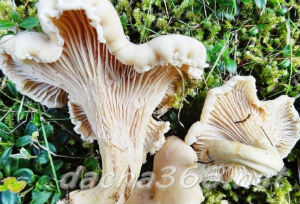
The variety is quite rare, it is not so common. But these mushrooms are very tasty. Therefore, they are really being hunted, it is not easy to get such a trophy.

Chanterelle grows in small groups in deciduous or mixed forests. Collect it from July to September.
Faceted
- It is found most often in the forests of North America. The body of the fungus is dark orange, funnel-shaped, 3-10 cm in diameter.
- The top resembles a hat, the edges of which hang down in waves.
- The pulp is dense, but brittle, has a pleasant aroma.
- The leg reaches 2.5 cm in length. You can find groups of these mushrooms or single specimens. Collect faceted chanterelle in summer, until mid-autumn.
 The faceted chanterelle has a special value because of the painting in its composition. Therefore, this species is valued above other mushrooms and even some vegetables.
The faceted chanterelle has a special value because of the painting in its composition. Therefore, this species is valued above other mushrooms and even some vegetables.
In addition, the faceted chanterelle is often used for medicinal purposes. It is accepted by obese people. Substances from the juice of this type of fungus fight acute inflammation. It has immunostimulating and antitumor effects.
Tubular (funnel-shaped)

This species is found in temperate climates, in coniferous forests. Prefers shade or damp place. This chanterelle is often hidden among the moss and foliage, making it difficult to find. The collection is carried out in August - September.
This species is considered a rare delicacy. A fragrant soup, dry powder is prepared from it, they are fried, pickled or frozen for the winter.
Velvety
- This is a rare edible chanterelle species.
- They have a velvety cap 4-5 cm in diameter. In small fruits, the cap resembles a convex dome, in adults, a funnel.
- The leg is slightly narrowed at the ground, reaches a height of 2-3 cm, sometimes it can stretch up to 7 cm.
- The mushroom appears curly due to the wavy edges of the cap. The shades of the tops are different: from light yellow to bright orange or red.
- The pulp is very tender and velvety. The aroma is pleasant, and the taste is slightly sour.
 This is a lamellar type of mushroom, thick and dense plates of which are interconnected by veins. This mushroom is very picky and selective for soil and climate.
This is a lamellar type of mushroom, thick and dense plates of which are interconnected by veins. This mushroom is very picky and selective for soil and climate.
The velvety chanterelle has an extraordinary taste. It is very much appreciated for its excellent taste and medicinal properties.
Yellow
- Caps of this species are yellow-orange or bright egg yolk.
- The tops reach 5-10 cm in diameter, depending on age, they can be convex, elongated or flat.
- The pulp is firm, the same shade as the dome. The edges are rounded, the skin is smooth to the touch.
 The taste is slightly different from other representatives of this species. Yellow chanterelles have a pungent taste with a spicy forest aroma. The processed spore powder is yellow.
The taste is slightly different from other representatives of this species. Yellow chanterelles have a pungent taste with a spicy forest aroma. The processed spore powder is yellow.
Mushrooms grow in mixed and deciduous forests, often hide in moss or grass, and can be found in humid places. The harvest season begins in June and can last until the coldest months.




